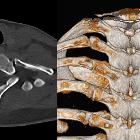persistent right umbilical vein
A persistent right umbilical vein (PRUV) is an uncommon vascular anomaly which is often detected in utero.
Epidemiology
The estimated prevalence is ~2 per 1000 births .
Pathology
In the normal situation, the right umbilical vein begins to obliterate in the ~4 week of gestation and disappears by the 7 week. With a PRUV, the right umbilical vein remains open and the left umbilical vein usually obliterates. A PRUV may also be supernumerary .
Location
A PRUV can be intra- or extrahepatic. The former is much commoner.
Associations
Numerous associations have been described (albeit at relatively low rates ). They are commoner with the extrahepatic type and include:
- single umbilical artery: especially in the extrahepatic type
- chromosomal anomalies
- Noonan syndrome
- situs anomalies
- congenital cardiac anomalies
- congenital renal anomalies
- congenital gastrointestinal anomalies
- vertebral anomalies
Radiographic features
Antenatal ultrasound
It is usually detected in the 2to 3 trimester. Assessment is usually made in the axial plane and color Doppler is often required. An intrahepatic persistent right umbilical vein may be seen as an umbilical vein abnormally connected to the right portal vein and the fetal gallbladder is positioned medial to the PRUV.
Treatment and prognosis
When additional anomalies are ruled out, a PRUV in isolation carries a generally favorable outcome .
Practical points
If a persistent right umbilical vein is detected, a careful sonographic anatomical survey is generally recommended to rule out more serious congenital malformations .
Related articles
Siehe auch:
- angeborene Wirbelanomalien
- angeborene renale Anomalien
- Trisomie 18
- singuläre Nabelschnurarterie (sNSA)
- Dextrokardie
- Noonan-Syndrom
und weiter:

 Assoziationen und Differentialdiagnosen zu persistent right umbilical vein:
Assoziationen und Differentialdiagnosen zu persistent right umbilical vein:




